Shortly after signing his seven-year, $81.5 million contract, Artemi Panarin took to social media to ask fans to aid his decision on what number the Russian winger will don next season. #10 was victorious.
Throughout history, a number of former Rangers have taken the Madison Square Garden ice with “10” stitched on the back of their jersey. Some players are in recent memory, while others we may need to dust off the history books to get a better look.
J.T. Miller
A quick look back to the 2017-18 season will show a time when J.T. miller honored the number. He wore #10 for five seasons with New York. Miller was homegrown, as he developed in the Rangers’ organization after he was drafted 15th overall by New York in the 2011 NHL draft. Miller wore #47 in his first stint in the NHL, the 2012-13 season, where the nineteen-year-old played in 26 games, splitting time between the Rangers and their recently rebranded minor league affiliate, the Connecticut Whale. After the departure of Marian Gaborik the following season, Miller adopted #10.
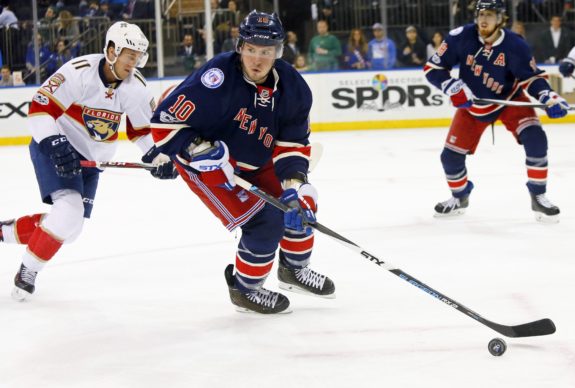
In 2014-15, after starting the first 18 games with the Hartford Wolfpack, Miller was recalled by the Rangers and earned a full-time spot on the roster, where he played in 58 games. In the 2015-16 season, Miller had a breakout year as he played in all 82 games and even spent time on the top line with Derek Stepan and Mats Zuccarello. Following the season, Miller signed a two-year, $5.5 million contract.
On Feb. 26, 2018, Miller was traded with Ryan McDonough at the trade deadline to the Tampa Bay Lightning for Vladislav Namestnikov, a first-round pick in the 2018 draft (Nils Lundkvist), and a conditional second-round pick in the 2019 draft (Karl Henriksson).
Miller, a fan favorite, was viewed as a building block for the future, due to his talent and youth. With the Rangers, he was a third-line player who found ease with the transition to a top-six role as either a center or a winger. Miller demonstrated this versatility many times under head coach Alain Vigneault. Miller is regarded as a great skater, with a heavy shot, whose positional play and situational awareness have improved tremendously. While with the Rangers, Miller tallied 172 points, including 72 goals and 100 assists in 341 games. He was traded to the Vancouver Canucks from the Lightning this offseason and will play a vital role in the Canucks development next season.
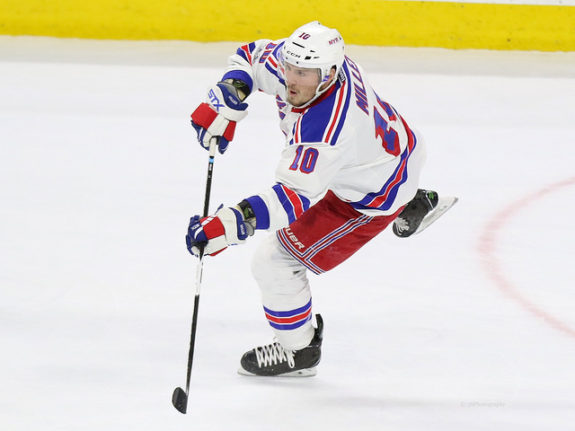
Marian Gaborik
As mentioned above, Marian Gaborik wore the coveted #10 prior to JT Miller. On July 1, 2009, Gaborik signed a five-year contract worth $37.5 million with the Rangers as an unrestricted free agent. Upon his arrival, the Rangers’ locker room would see a heavy addition upfront regarding both skill and leadership, as Gaborik was the captain of the Minnesota Wild during the 2007-08 season.
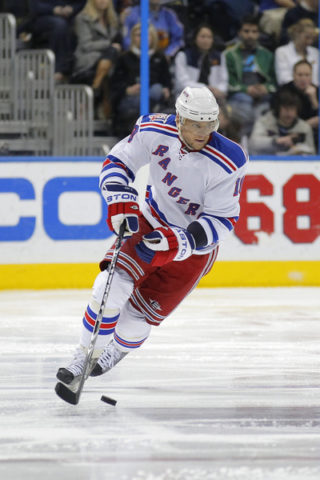
Gaborik played four seasons in New York and was extremely steady in his point distribution totals. He had 114 goals and 115 assists totaling 229 points in 255 games played. In his first season with New York, he scored 42 goals and had 86 points. A player is usually generalized as either a passer or a shooter. In Gaborik’s case, he was both, which gives a nod to his elite-level hockey IQ to be able to make the correct decision in a given scenario.
Along with his hockey sense, Gaborik was known for his explosive speed, smooth hands, and quick release. He also had a sense for the front of the net. Gaborik could squeeze his way in tight areas for quick, one-touch goals, as we can see in this memorable goal when he scored the game-winner against the Washington Capitals in the Eastern Conference Semifinals ending one of the longest games in Rangers’ playoff history.
Gaborik suffered a few injuries in New York, including a shoulder, knee, and leg injury, which hampered his play at times. Overall, Ranger fans loved the star power he brought to the lineup and didn’t want to see him leave. The return that came from the trade from the Columbus Blue Jackets would ease the sting, however. Gaborik was traded from New York Rangers with Blake Parlett and Steven Delisle to the Blue Jackets for Derick Brassard, Derek Dorsett, John Moore and a sixth-round pick in the 2014 draft (Chase Lang). Brassard, the centerpiece of the trade, became a proven playoff performer during his time with the Rangers.
Ron Duguay
Our next Ranger is one that has made his mark in Rangers’ history as not only a player but as a media icon and rockstar: Ron Duguay.
Duguay was drafted 13th overall in the 1977 NHL Draft by the Rangers and would make the jump to the NHL the following season in 1977-78. Duguay was a great player with offensive upside, scoring 20 goals in his rookie campaign, but also loved to play a hard checking style. The Rangers reached the Stanley Cup Final in the 1978-79 with Duguay in the lineup but lost to a dominant Montreal Canadiens team in five games. Years later, Duguay led the 1981-82 Rangers in scoring with 40 goals and represented the Rangers in the NHL All-Star Game in the same season. Duguay played 499 games with the Rangers tallying 164 goals and 176 assists for 340 points. He also had 370 penalty minutes
Duguay played in an era where helmets were optional. Just as #10 represented his on-ice persona during his two stints with the Rangers, his long, flowing hair and lavish New York City nightlife were staples of his off-ice personality. Following his second stint with the Rangers, Duguay bounced around several minor league hockey leagues before he found himself back with the Rangers in 2007, but this time as a television analyst for MSG Networks covering Ranger games.
Duguay maintained his 80’s fashion sense that drove the Manhattan crowd to fall in love with the Sudbury, Ontario native in the first place. He catered to the older crowd who liked his hard-nosed approach to the game but also drew in the youth with his style and cockiness. But as all things must come to an end, Duguay caught up with the times. In 2015, he chopped his hair and hung the bizarre, printed suits in his closet. The transformation portrayed a stronger professional and serious image. Duguay was known for speaking his mind and being direct, a characteristic some liked, while others found offensive. He occasionally crossed a line, including in his criticization of the Rangers’ performance. In 2018, Duguay’s contract would expire and MSG Networks decided not to renew. Duguay was disappointed and taken aback in the harsh parting from the network.
Duguay can still be seen on camera, but now doing charity work alongside fellow Rangers alumni, including Adam Graves and Stephan Matteau. The Rangers alumni community does an excellent job to give back to the game that gave them everything and Duguay is at the forefront.
Esa Tikkanen
In March 1993, The Rangers made a trade with the Edmonton Oilers to acquire the four-time Stanley Cup Champion, Esa Tikkanen, in exchange for a 22-year-old Doug Weight.
General manager Neil Smith tinkered with the roster to strengthen a push for the playoffs. Tikkanen, being a solid defensive veteran in the league with offensive capabilities, aided the Rangers the following season, as that team would go down in history for the famous 1994 Stanley Cup Championship.
The son of a boxer, the 28-year-old played a tenacious, agitating game. He drove opposing players crazy with his scrappy style, giving him the renowned league-wide nickname, “Tick.” Teammates recalled Tikkanen had his own special language, “Tikkanese”, a hurried and butchered mix of English and Finnish. Most times, teammates would have trouble depicting the context of the message, but from his vigor could gather the importance. In a city like New York, Tikkanen’s energy and style sat well with fans. Tikkanen had 54 points, including 22 goals and 32 assists in 83 regular-season games. In the playoffs, he played in 23 games contributing for 8 points and 34 penalty minutes.
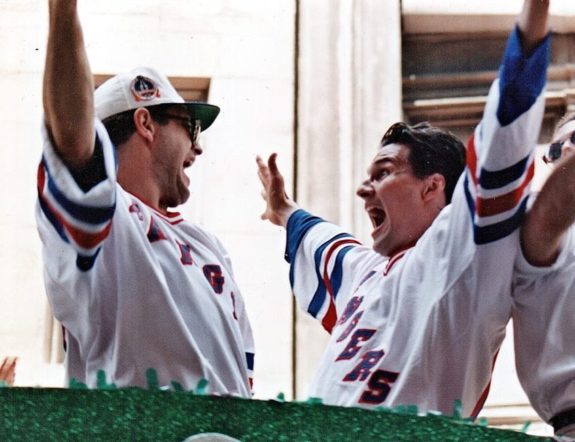
Just 10 days after the championship, Tikkanen was on the move. He was traded with Doug Lidster to the St. Louis Blues for Petr Nedved. Tikkanen returned to the Rangers three more times throughout his career ultimately playing in a total of 144 games with the Rangers, all while wearing #10.
Guy Lafleur
At 37-years-old and already inducted into the Hockey Hall of Fame, Guy Lafleur decided to come out of retirement. Three years removed from the league, the winger suited up for the Rangers training camp after Mark Messier convinced management to give Lafluer the chance to prove his worth. Lafleur impressed head coach Michel Bergeron as he played well enough to earn a one-year contract from general manager Phil Esposito. Beyond any doubt, Lafluer wore #10.
In his first game back to the Montreal Forum, Lafleur received a standing ovation as he took the ice for warmups. The crowd cheered and chanted the famous, “Guy! Guy! Guy!” every time he touched the puck. Lafleur scored twice on goaltender Patrick Roy and both times the forum erupted in applause. He was named the first star of the game.
“The Flower” played well in his 67 games in New York. He scored 18 goals and 27 assists for 45 points. Ensuing his comeback season, Lafleur followed Michel Bergeron, who had been dismissed by the Rangers, to the Quebec Nordiques where he played two more seasons before retiring, this time for good. Lafleur finished his career where his love for the game of hockey began.
The Future: Artemi Panarin
Early life for Panarin was much different than the world that emerges once one becomes a professional athlete. Born in the small town of Korkino, a mining town located in the Ural Mountains of Russia, he was raised by his grandparents, Vladimir and Nina Levin, who had little money, but huge hearts. His grandfather drove countless hours in an old, rusted World War II utility vehicle, called a-YA3-469, to get his grandson to practice. Vladimir scavenged the town, including the rink trash bin to find equipment that usually was way too big and mangled, but could be mended to get the job done.
His grandfather fixed his gloves by using leather from a worn-out pair of boots to replace the absent palms. He also wore skates that were so big that he needed to wear his shoes inside his skates to fit. His grandmother was a seamstress who sold baked goods and milk from the family cow, so they could afford gas. Nina had to stitch his sweaters to resemble what the other boys were wearing, but could only do so much. His teammates would take notice of his “style” and mock him, but Panarin, maturely, ignored the bullying. His family had no idea he would eventually leave Russia to become an NHL star, but knew they were going to give their grandson every opportunity to grow and develop not only as a player but as a person.
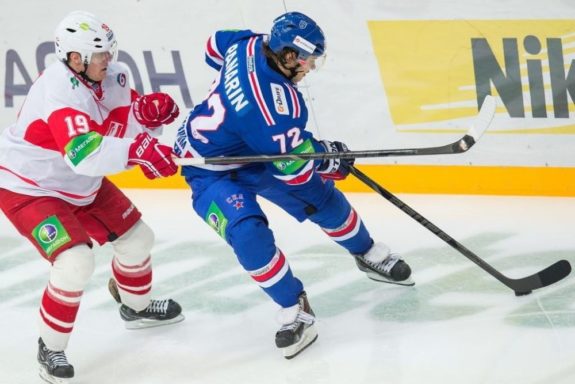
Before Panarin signed with the Chicago Blackhawks in 2015, he began his career with eight seasons in the KHL with Chekhov Vityaz and St. Petersburg SKA. He struggled early with Chekhov Vityaz, but took off when he was traded to St. Petersburg SKA. In 2014-15, he helped them win the Gagarin Cup in the KHL playoffs, where he had 20 points in 20 playoff games.
Before he became a borderline point-per-game player in the NHL, Panarin had to understand the dedication required to earn a spot on a roster, especially being undrafted. The work ethic that the 27-year-old developed transpired from his rough upbringing. He has a chip on his shoulder and the burning desire to have success in not just hockey, but life. Panarin is no stranger to the grind, as he has battled a great deal of adversity to become one of the top players in the best league in the world. His motivation to provide for his family is his ultimate tool. Even if he still had his old gloves and skates, he would get the job done, as his grandfather did for him so many years ago. #10 is in good hands with Panarin.